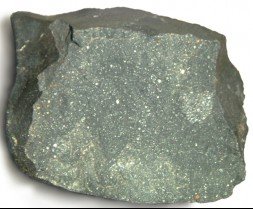Seemingly endless meteor storms that bombarded the Earth four billion years ago helped to create the right growing conditions from which life could first emerge. The same meteoric bombardment may also have had a similar effect on our planetary neighbour Mars.
Richard Court and Mark Sephton of the Department of Earth Science and Engineering, at Imperial College London and their colleagues publish details of a theory that could change our understanding of natural terraforming of the primordial Earth this month in the journal Geochimica et Cosmochima Acta.

Professor Mark A. Sephton
The researchers have analysed the remaining mineral and organic content of fifteen fragments of ancient meteorites to see how much water vapour and carbon dioxide they would release when subjected to very high temperatures. The experiments aimed to replicate the conditions experienced by the meteoric material as it entered the Earth’s atmosphere billions of years ago.
When a meteor enters a planet’s atmosphere, extreme heat is produced because of the retarding compression of the air due to the meteor travelling at supersonic speeds. This heat causes some of the minerals and organic matter on the meteor’s outer crust to vaporise releasing water and carbon dioxide before it breaks up or hits the ground.

A fragment of the Murchison meteorite was analysed by the IC team
This water source could have added large quantities of moisture to the atmospheres of both Earth and Mars billions of years ago. Moreover, the addition of the greenhouse gas carbon dioxide to the atmosphere would have helped trapped solar energy and so make the primordial planets warm enough for liquid oceans.

Meteoric bombardment of the early Earth may have paved the way for life to emerge
Court and Sephton used a novel analytic technique known as pyrolysis-FTIR spectroscopy to test the meteorites. The pyrolysis process involved blasting a meteorite fragment with electricity to heat it from room temperature at a rate of 20,000 degrees Celsius per second to 250 Celsius or 1000 Celsius to cause the material to break apart and vaporize. FTIR, or Fourier-transform infra-red spectroscopy, then provides a chemical fingerprint of any small molecules, such as water and carbon dioxide, produced.
For a long time, scientists have been trying to understand why Earth is so water rich compared to other planets in our solar system, Sephton explains. The team found that on average, each meteorite fragment could release 12% of its weight as water vapour and 6% as carbon dioxide gas. These figures, the researchers suggest, are not enough that a few small meteorites could have made a significant contribution to the atmosphere’s water and carbon dioxide levels.
However, the team also analysed data from an ancient meteorite shower called the Late Heavy Bombardment (LHB), which occurred 4 billion years ago, where millions of rocks crashed to Earth and Mars over a period of 20 million years. They calculated that the LHB could have added 10 billion tonnes of carbon dioxide and 10 billion tonnes of water vapour to the planets’ atmospheres every year. This rate of addition is certainly adequate to make both planets warmer and wetter enough to sustain life.
The LHB provides a missing clue. This may have been a pivotal moment in our early history where Earth’s gaseous envelope finally had enough of the right ingredients to nurture life on our planet, adds Sephton.
Because of their chemistry, ancient meteorites have been suggested as a way of furnishing the early Earth with its liquid water, says Court, Now we have data that reveals just how much water and carbon dioxide was directly injected into the atmosphere by meteorites. These gases could have got to work immediately, boosting the water cycle and warming the planet. Of course, the existence of life on Earth is obvious, but habitable conditions on Mars apparently did not last. Unlike Earth, Mars has no magnetic field to shield it from the Sun’s lethal solar wind, its atmosphere was eventually mostly stripped away, and warming volcanic activity subsided. As such any liquid water retreated to the frozen poles leaving behind the barren red planet with which we are almost familiar.
Further reading
Geochim. Cosmochim. Acta, 73 (11), 1 June 2009, 3512-3521
Professor Mark A. Sephton
http://www3.imperial.ac.uk/people/m.a.sephton
Suggested searches
meteorites